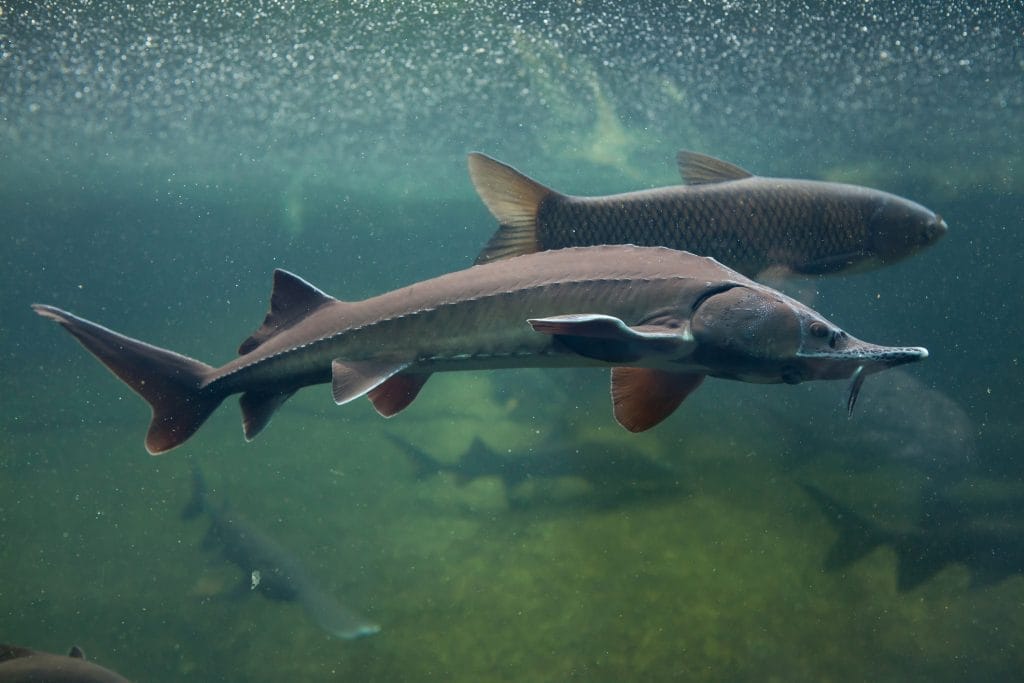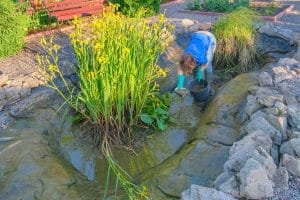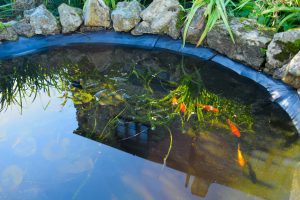
Transform your garden pond with essential tips for sturgeon care! Ensure a thriving habitat for your fish. Discover our top recommendations today!
Sturgeon are fascinating fish with prehistoric origins, making them a unique addition to garden ponds. These ancient creatures can thrive in well-maintained outdoor water features, provided their specific needs are met.
Sturgeon require large ponds with excellent filtration, cool water temperatures, and a specialised diet to flourish in a garden setting.

Keeping sturgeon in garden ponds is not a task to be taken lightly. These fish can grow quite large and have particular requirements for their care. Proper feeding is crucial, especially during winter months when sturgeon remain active at lower temperatures.
A varied diet of high-quality pellets, sized appropriately for the fish, helps ensure their health and longevity.
Sturgeon-friendly ponds should be spacious, deep, and free from sharp objects that could harm these bottom-dwelling fish. Good water quality is essential, as is providing areas for the sturgeon to rest and hide.
With proper care and attention to their needs, sturgeon can become impressive, long-lived residents of your garden pond.
Key Takeaways
- Sturgeon need large, well-filtered ponds with cool water to thrive
- Proper nutrition, including winter feeding, is vital for sturgeon health
- Garden ponds for sturgeon must be deep, spacious, and free from hazards
Understanding Sturgeon
Sturgeon are ancient fish with unique physical traits. They belong to a diverse family with many species found worldwide.
Sturgeon Taxonomy and Species
Sturgeon are members of the Acipenseridae family. This group includes 27 species that have existed for millions of years. Some well-known types are:
- Sterlet: A smaller species suitable for garden ponds
- Siberian sturgeon: Hardy and adaptable to various climates
- Beluga sturgeon: One of the largest freshwater fish
- Diamond sturgeon: Known for its distinctive appearance
Hybrids between species also exist. The smallest sturgeon reach about 1 metre, while the largest can grow over 6 metres long.
Physical Characteristics
Sturgeon have several unique features:
- Cartilaginous skeleton
- Rows of bony plates (scutes) along their bodies
- Elongated, flattened snouts
- Protruding mouths on the underside of their heads
- Barbels near the mouth for sensing food
Their appearance hasn’t changed much in millions of years. Sturgeon lack scales and have smooth skin between their scutes.
They can vary greatly in size, with some species reaching over 61 cm in garden ponds. Their distinctive look makes them stand out from other fish.
Essentials of Sturgeon Care

Proper sturgeon care requires close attention to water quality, oxygen levels, and filtration. These factors are crucial for keeping sturgeons healthy in garden ponds.
Water Quality and Parameters
Sturgeons need clean, well-oxygenated water to thrive. The ideal pH range for sturgeon ponds is 6.5 to 8.5. Regular testing is essential to maintain proper levels.
Dissolved oxygen is critical for sturgeon health. Aim for at least 6 mg/L.
Use aerators or waterfalls to boost oxygen levels, especially in warm weather.
Water temperature should remain stable. Sturgeons can tolerate 4°C to 25°C, but sudden changes can be harmful. Monitor temperature regularly and avoid drastic fluctuations.
Ammonia and nitrite levels must be kept at zero. Test weekly and perform water changes if levels rise. Nitrate should stay below 40 ppm.
Filtration System Requirements
A robust filtration system is vital for sturgeon ponds. It removes waste and maintains water quality. Choose a filter rated for at least twice your pond volume.
Mechanical filtration removes debris and particles. Use fine mesh or foam to catch small particles.
Biological filtration breaks down harmful ammonia. Use media with high surface area, like bio-balls or ceramic rings.
UV sterilisers help control algae growth. Install one after mechanical filtration for best results.
Clean filters regularly to prevent clogging. Rinse media in pond water to preserve beneficial bacteria.
The Sturgeon Diet

Sturgeons have unique dietary needs that pond owners must understand. Proper nutrition is key to their health and growth in garden ponds.
Feeding Behaviours and Preferences
Sturgeons are carnivorous benthic feeders, meaning they search for food at the bottom of ponds. They use their tube-like mouths to suck up small prey and plants. In the wild, sturgeons eat worms, small fish, and crustaceans.
In garden ponds, sturgeons need a diet that mimics their natural food sources. High-quality pellet food designed for sturgeons is best.
The pellet size should match the sturgeon’s size:
- 3mm pellets for 15-36cm sturgeons
- 4.5mm pellets for 30-50cm sturgeons
- 6mm pellets for 36-61cm sturgeons
- 8mm pellets for sturgeons over 61cm
Feed sturgeons 2-3 times daily, offering only what they can eat in a few minutes.
Nutritional Requirements
Sturgeons thrive on a high protein diet. Their food should contain at least 40% protein and 15% lipids for healthy growth. Commercial sturgeon pellets meet these needs.
It’s vital to feed sturgeons year-round, even in winter. They can feed at temperatures as low as 4°C.
Many sturgeons die from winter starvation, so continue feeding when water temperatures drop.
Vitamins and minerals are crucial for sturgeon health. Look for foods fortified with:
- Vitamin C for immune support
- Vitamin E as an antioxidant
- Calcium for bone health
Vary the diet occasionally with treats like earthworms or bloodworms. This provides extra nutrients and mental stimulation for the fish.
Designing a Sturgeon-Friendly Garden Pond

Creating the right environment is key for happy, healthy sturgeons. A well-designed pond provides space, proper habitat, and essential elements for these unique fish to thrive.
Pond Size and Depth
Sturgeons need ample room to swim and grow. A large pond is crucial for their wellbeing. The minimum size should be at least 3 metres wide and 4.5 metres long. Depth is equally important, with a minimum of 1.2 metres required.
Deeper areas of 1.5 to 1.8 metres are ideal. This extra depth helps maintain stable water temperatures and gives sturgeons space to move vertically.
The pond’s shape matters too. Long, narrow designs allow sturgeons to swim in straight lines, mimicking their natural behaviour. Avoid circular ponds, as they can cause stress.
A sturdy filtration system is essential. It keeps the water clean and well-oxygenated, which sturgeons need to thrive.
Plant Life and Sturgeon Habitat
While sturgeons don’t eat plants, vegetation plays a vital role in their habitat. Floating plants provide shade and help regulate water temperature.
Water lilies and other surface plants create a natural, calming environment. They also offer shelter from predators like herons.
Submerged plants like hornwort or elodea help oxygenate the water. This is crucial for sturgeon health.
Avoid plants with trailing roots or dense growth near the bottom. Sturgeons can get tangled in these.
Include some open areas in your pond design. Sturgeons need clear spaces to swim freely.
Adding rocks or logs at the bottom creates a more natural habitat. It gives sturgeons places to rest and explore.
Co-Habitation with Other Species
Sturgeons can live with other fish in a garden pond, but careful planning is needed. The right mix of species helps create a balanced ecosystem.
Compatible Pond Mates
Koi and goldfish often make good companions for sturgeons. These fish share similar water quality needs and tend to get along well. Orfe and ide can also be suitable pond mates.
When choosing fish to live with sturgeons, consider size. Smaller fish may become prey, so it’s best to select species that grow to a similar size.
Sturgeons are bottom-feeders, while koi and goldfish feed at different levels. This reduces competition for food. Make sure to provide enough space for all fish to thrive.
Potential Risks and Benefits
Co-habitation has risks and rewards.
On the plus side, a mix of species can create a more interesting pond ecosystem. Different fish add visual appeal and may help control pests like mosquito larvae.
The main risk is aggression or predation. Large sturgeons might eat smaller fish. Some fish may nip at sturgeons’ sensitive barbels.
To reduce these risks, introduce fish of similar sizes and provide plenty of hiding spots.
Overfeeding can lead to poor water quality, harming all pond inhabitants.
Feed each species the right amount and type of food to keep the pond healthy.
Health and Disease Management
Keeping sturgeons healthy requires vigilance and proper care.
Identifying common ailments and taking preventive measures are key to maintaining thriving sturgeon in garden ponds.
Common Sturgeon Ailments
Sturgeons can face several health issues in pond environments.
Parasites are a frequent concern, with external parasites like ich and flukes being particularly problematic. These can cause skin irritation and respiratory distress.
Bacterial infections are another threat. They often result from poor water quality or stress. Signs include skin lesions, fin rot, and abnormal swimming behaviour.
Fungal infections, typically appearing as cotton-like growths on the skin or fins, can develop on injured areas or when water conditions are poor.
Nutritional deficiencies may occur if the diet is not balanced. This can lead to stunted growth, skeletal deformities, or a weakened immune system.
Prevention and Treatment
Maintaining excellent water quality is crucial for sturgeon health.
Regular testing and filtration are essential. Proper nutrition also plays a vital role in disease prevention.
When ailments occur, prompt action is necessary.
For parasites, salt baths or approved medications can be effective.
Bacterial infections often require antibiotic treatment prescribed by a veterinarian.
Fungal issues typically improve with better water quality and salt treatments.
Addressing nutritional deficiencies involves adjusting the diet to include a variety of high-quality foods.
Quarantine new fish before introducing them to the pond to prevent disease spread.
Regular health checks help catch problems early. Always consult a fish health specialist for serious concerns.
Feeding Practices and Schedules
Proper feeding is crucial for sturgeon health in garden ponds. A consistent routine and adjusting for seasonal changes help meet their nutritional needs.
Regular Feeding Routine
Sturgeons are bottom dwellers and require a specific feeding approach.
Offer food 2-3 times daily, focusing on dawn and dusk when they’re most active. Use high-protein sinking pellets sized appropriately for your fish.
For smaller sturgeons (15-36 cm), use 3 mm pellets. Larger fish (36-61 cm) need 6 mm pellets.
Fish over 61 cm require 8 mm pellets.
Scatter food across the pond bottom to encourage natural foraging behaviour. Remove uneaten food after 30 minutes to maintain water quality.
Seasonal Dietary Changes
Sturgeon feeding habits change with the seasons.
In summer, they eat more frequently due to higher metabolism. Increase feeding to 3-4 times daily during warm months.
As temperatures drop, reduce feeding frequency but don’t stop entirely.
Sturgeons feed down to 4°C, so it’s vital to provide food in winter to prevent starvation.
In spring and autumn, adjust feeding gradually. Monitor water temperature and fish activity to determine the right amount.
Always ensure other pond fish are well-fed to reduce competition for sturgeon food.
Growth and Lifespan
Sturgeon are remarkable fish known for their slow growth and long lives. Their size and longevity vary greatly between species, with some reaching enormous proportions over many decades.
Understanding Growth Rates
Sturgeon grow very slowly compared to many other fish species. Their growth rates depend on factors like water temperature, food availability, and genetics.
Most sturgeon species grow about 10-15 cm per year in their first few years of life.
As they age, their growth rate slows down. Pond sturgeon can reach lengths of 60-90 cm in garden ponds.
Larger species like the beluga sturgeon can grow much bigger in the wild, potentially reaching 6 metres or more.
Different sturgeon species have varying growth rates:
- Sterlet: 60-100 cm in 10-15 years
- Siberian sturgeon: 100-150 cm in 15-20 years
- Russian sturgeon: 100-200 cm in 20-25 years
Water quality, diet, and space greatly affect sturgeon growth in ponds. Proper care is crucial for healthy development.
Lifespan Expectancy
Sturgeon are renowned for their longevity. In captivity, with proper care, many species can live for several decades. Some wild sturgeon have been known to live for over a century.
Typical lifespans for common pond sturgeon species:
- Sterlet: 25-30 years
- Siberian sturgeon: 50-60 years
- Russian sturgeon: 50-70 years
Proper feeding in winter is vital, as many sturgeon deaths in ponds occur due to starvation during colder months.
Larger ponds generally allow for longer lifespans, as they provide more space and stable conditions. Sturgeon in smaller ponds may have shorter lifespans due to stress and limited resources.
Handling and Maintenance
Proper handling and regular maintenance are crucial for sturgeon health in garden ponds. These practices help prevent stress and injury while ensuring optimal water conditions.
Safe Handling Tips
When handling sturgeon, use wet hands or gloves to protect their sensitive skin. Avoid touching their gills and eyes.
For larger fish, a soft mesh net can be used. Lift the sturgeon gently, supporting its body length.
Never grab a sturgeon by its tail or gills. This can cause serious harm.
If you need to move a sturgeon, use a container filled with pond water. Keep the fish submerged at all times.
Limit handling to essential tasks like health checks or pond cleaning. Frequent handling can stress the fish and remove their protective slime coat.
Regular Pond Maintenance
Clean your pond regularly to keep sturgeon healthy. Remove debris like fallen leaves and excess algae.
Check water quality weekly, testing for ammonia, nitrite, and pH levels.
Perform partial water changes every 2-4 weeks. Replace 10-20% of the pond water with fresh, dechlorinated water. This helps maintain good water quality.
Keep filters clean and functioning properly. Rinse filter media in pond water to preserve beneficial bacteria. Replace or clean UV sterilisers as needed.
Monitor water temperature, especially during seasonal changes. Sturgeon are sensitive to rapid temperature shifts. Use a pond thermometer for accurate readings.
Troubleshooting Common Issues
Keeping sturgeons healthy in a garden pond requires watchful care. Issues can arise with water quality and fish behaviour. Quick action is key to solving problems.
Algae and Water Clarity
Algae growth can harm water quality for sturgeons. Blanket weed is a common issue in ponds. It can clog filters and reduce oxygen levels.
To combat algae:
- Remove excess by hand or with a rake
- Use pond plants to absorb nutrients
- Install a UV clarifier
Proper filtration is vital. Check and clean filters regularly. Test water parameters weekly. Aim for:
| Parameter | Ideal Range |
|---|---|
| pH | 6.5 – 8.0 |
| Ammonia | 0 ppm |
| Nitrite | 0 ppm |
| Nitrate | < 40 ppm |
Behavioural Observations
Watch for unusual sturgeon behaviour. It can signal health issues.
Sturgeons lying on the bottom or swimming oddly may be ill.
Signs of trouble:
- Lack of appetite
- Gasping at the surface
- Rubbing against objects
- Unusual swimming patterns
These may indicate sturgeon diseases or poor water quality.
Check oxygen levels if fish gasp at the surface. Add an air pump if needed.
Eating issues are common. Ensure sturgeons get proper food.
They may try to eat other fish’s slime coat if hungry. Feed a varied diet of sinking pellets and live foods.
Related Posts
- 10 Common Mistakes Homeowners Make with Their Ponds: Ensuring a Healthy and Beautiful Water Feature
- Koi White Spot Treatment: Effective Solutions for Your Pond Fish
- Top Pond Installers: Your Guide to Quality Pond Construction
- Essential Guide: Preparing Your Pond for Spring
- Who’s Hunting My Pond Fish in the UK: Identifying Predators and Protecting Your Aquatic Life
- Why is There Foam on My Koi Pond? Understanding Causes and Solutions
- How to Beautifully Illuminate Your Pond with Pond Lighting: Expert Tips for Glowing Waters
- Do Ponds Need Water Changes? Understanding Maintenance for Healthy Ecosystems


